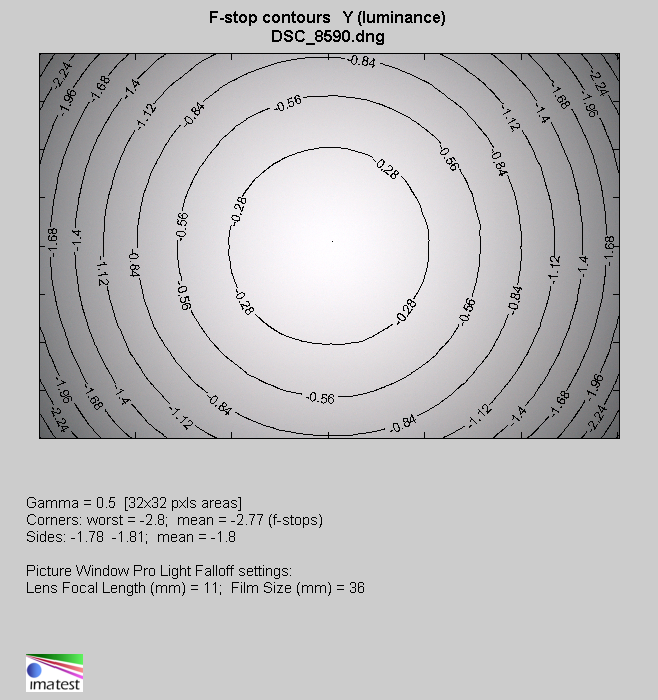Nikon Nikkor Z 35 mm f/1.4
8. Vignetting
| Z7, APS-C/DX, JPEG, f/1.4 | Z7, APS-C/DX, JPEG, f/2.0 |

|

|
At the maximum relative aperture vignetting is noticeable because it reaches 29% (−1.00 EV). Fortunately, it is not a big effect. By f/2.0 and f/2.8 this aberration decreases to a negligible level, 14% (−0.45 EV) and 8% (−0.23 EV) respectively. When it comes to RAW files that are not automatically corrected, the results are by 2-3% higher.
Please Support UsIf you enjoy our reviews and articles, and you want us to continue our work please, support our website by donating through PayPal. The funds are going to be used for paying our editorial team, renting servers, and equipping our testing studio; only that way we will be able to continue providing you interesting content for free. |
- - - - - - - - - - - - - - - - - - - - - - - - - - - - - - - - - - - - - - - - - - - - - - - -
Now let's check the situation on full frame. In this case we have to show photos saved as both JPEG and RAW formats. Correction of vignetting can be switched off in both cases but JPEGs are automatically distortion-corrected and cropped anyway. As the level of this distortion is high also the cropping of images is quite significant.
| Z7, FX, JPEG, f/1.4 | Z7, FX, RAW, f/1.4 |

|

|
| Z7, FX, JPEG, f/2.0 | Z7, FX, RAW, f/2.0 |

|

|
| Z7, FX, JPEG, f/2.8 | Z7, FX, RAW, f/2.8 |

|

|
On JPEG files at the maximum relative aperture you have to take into account the loss of light in frame corners reaching as much as 58% (-2.51 EV). That value decreases to 39% (-1.41 EV) on stopping down the aperture to f/2.0 and to 32% (-1.11 EV), after applying the f/2.8 relative aperture.
By the f/4.0 aperture vignetting amounts to 26% (-0.86 EV), and by f/5.6 it decreases to 21% (-0.67 EV). The problem becomes marginal by f/8.0 and f/11.0, where we got the following results: 17% (-0.54 EV) and 14% (-0.44 EV) respectively.
On RAW files the problems are even more serious. Here by f/1.4 vignetting reaches a very high level of 62% (-2.77 EV) and it decreases to 47% (-1.86 EV), on stopping down the aperture to f/2.0. Further stopping down, this time to f/2.8, is able to reduce this aberration to a value of 42% (-1.57 EV). By f/4.0 and f/5.6 you deal with a still noticeable level and we got there the following results: 38% (-1.39 EV) and 35% (-1.27 EV). Vignetting makes itself felt even by f/8.0 and f/11.0, where it reaches 32% (-1.14 EV) and 25% (-0.83 EV).
| Nikon Z7, RAW, 35 mm, f/1.4 |
 |






